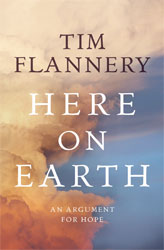
Text Publishing, 2010
RRP $34.95
A reflection by Chris Dalton, a Toowong Uniting Church member who is completing a Master of Arts in Public and Contextual Theology.
At first glance this book appears to be the latest in a growing list of ‘politically correct’ commentaries from the environmental movement, forecasting doom if humanity does not change its selfish exploitation of Earth’s resources, as suggested in the debate surrounding climate change.
Is Flannery just opportunistically cashing in on people’s fear of global warning, andstaking out hismoral high groundupon which he then outlines some sustainable strategies for preparing for a world population of 9 billion people (compared to 6.8 billion today)? Or does he articulate genuine grounds for hope amidst the prospect of environmental disaster?
To answer this you need to travel with Flannery on a journey of imagination that explores contrastingMedean andGaian hypothesesin order to discern a message of hope.
Palaeontologist Peter Ward’s Medea hypothesis, named after the terrifying Medea of Greek mythology, holds that species will, if left unchecked, destroy themselves by exploiting their resources to the point of ecosystem collapse.
Flannery suggests there are parallels in thishypothesis with a reductionist view of evolution (eg. the power of Darwinian competition ‘red in tooth and claw’), the ‘selfish gene’ theory of Richard Dawkins and the neo-classical Chicago School of economics.
He finds little cause for hope in this hypothesis, and the thought lingers that it reflectsa prevailing, albeit despairing, view of the human condition– even amongst environmentalists.
So from where does Flannery draw his hope?
The source is Gaia. Dawkins dismisses Gaia as ‘pop ecology literature’, so it is surprising that Flannery, a respected scientist and believer in reason, rationality and the Enlightenment, invokes Gaia.
James Lovelock’s Gaia hypothesis, named after the Greek goddess of Earth, holds that the earth is a self-regulating system made up of the totality of organisms it contains, and has the goal of regulating surface conditions to be as favourable as possible for contemporary life.
Flannery starts with this hypothesis in formulating a hope for the future, a future that he admits could include Gaia surviving in the very long term, but with disaster befalling many ecosystems and species (including humanity)in the short term.
But then Flannery talks of a potential for a profound change in Gaia: [f]rom her birth until now she has been a loosely coordinated entity lacking a command-and-control system … unable to regulate herself precisely, proposing that humanity can fill this void and give rise to the prospect of an intelligent Earth that would, through her global human superorganism, be able to foresee malfunction, instability or other danger and act with precision.
This sounds a bit far-fetched, moving even into the realm of science fiction, but it merits further attention.
Inbuilding his model of an intelligent Earth and a radically transformed humanity, he speaks of a commonwealth of virtue, of striving to love one another and of loving our planet as much as we love ourselves.
Further, he refers to a rendering of the word ‘evolution’ into Chinese characters that can be read in several ways, including ‘heaven’s performance’, where ‘heaven’ means all of creation.
His holistic vision begins to take on a spiritual as well as physical dimension.
And the points of contact with the Christian faith are very clear, even if Flannery didn’t necessarily have them in mind.
The Bible speaks of a new heaven and a new earth, of the need for radical transformation, of the importance of loving one another and the divine creation, of disaster resulting from untransformed ways, and of humanity having a role in serving God’s Earth.
For these reasons I found this book to be spiritually stimulating. It does not use ‘God’ language, nor does it attempt to put its message into an obviously theological framework (thisis achallenge for the reader!).
But it encourages you to think beyond the alarming Medean hypothesis that seems to permeate society today, and sets the scene for some constructive dialogue between science and religion, aimed at developing a common agenda for responding to the voice of the Earth.
Read the book, but be ready to let it take you beyond traditional scientific and religious dogma.
You may question his science and think his secular ‘solution’ is deficient, but don’t let that deter you.
Flannery presents the Gaian concept as an underlying metaphor in his narrative that calls for radical change.
He does not articulate a tight systematic scientific theory but uses some broad brush strokes to paint a vision, a vision to which we can contribute if we dare to venture into the risky uncharted waters of a re-enchanted science.
My personal response is to see Flannery’s vision as a sequel to the Garden of Eden story (Genesis 3): with our unique knowledge of Good and Evil (our ‘intelligence’?), how can we best serve the Earth (Genesis 2:15)?
This is, perhaps, best summarised in the following poemfirst publically read at the October 2008 Poets Breakfast in Eden, NSW, run by St Georges UCA.
The poem incorporates a cosmic, panentheistic Christ, whose saving act embraces the groaning of the whole of creation (Romans 8:22).
It is the image of the Suffering Servant (Isaiah 52:13-15) who absorbs the environmental destruction of humanity, rather than a wrathful Gaia, a”Mother Earth” rising up like a chthonic Jehovah to topple human empiresand return earth to pre-civilized simplicity… a justified revenge of “nature” against “civilisation”(Ruether, R. R., Gaia and God: an ecofeminist theology of earth healing, New York, HarperCollins Publishers, 1992).
HOPE
I see her hanging from a tree,
brilliant, radiant beauty:
deep blues of ocean,
red ochres of desert,
verdant greens of bush,
purple clouds of storm –
nature’s kaleidoscope, a glorious mosaic.
Gaia turns her head my way
and with horror then I sense
burning from her eyes the light,
acrid from her nose the fumes,
swollen tears of acid rain and
deep unutterable groans
that can’t be heard.
“Why”, she cries,
“forsake me so?
You know not what you do.”
Heart piercèd by my mute reply,
she shakes her head
and slumps and then
“It’s finished” is her sigh.
I bow my head in grief and shame
and see the tree from which she hangs,
itself once full of light and life,
and proud in Eden’s garden,
now twisted, gnarled and broken, too
with blue, red, green and purple hue,
with Gaia’s mosaic is woven.
Too late, I thought, to right the wrong,
but had I known the apple’s price
would I have wisdom sought?
Then as I look the outlines shift,
they leap and dance and shout and sing –
creation in the making.
Where once was tree and figure, now
is just a riotous, swirling mist
from which appears outside of time
her joyous, loving rapture.
 JourneyOnline
JourneyOnline






